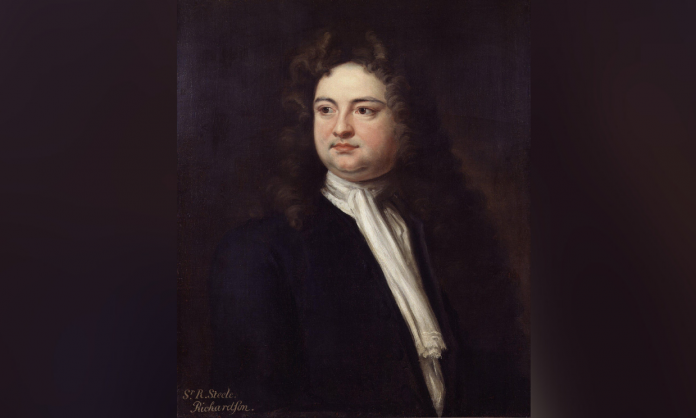By John Powell
A contemporary of such literary giants as Jonathan Swift, Alexander Pope and George Berkely, Richard Steele was born in Dublin in 1672. He was baptized in the church of Saint Bride (since demolished) and the country house at Monkstown in County Dublin where he grew up cannot be identified.
Of Ireland he declared “My family from which I am descended came originally out of Ireland; this has given me a natural affection for the country.” However, unlike Swift, Steele did not become involved in Irish politics but instead carved a career in literature and parliament in Britain.
Steele studied at Charterhouse School and Merton College Oxford and in the former met Joseph Addison who later became his collaborator. The Dubliner then became a cadet in the Life Guards and in 1694 dedicated a poem on the death of Queen Anne to Lord Cutts, the colonel of the Coldstream Guards regiment. As a result he became the colonel’s secretary and was promoted to the rank of captain.
The young Richard Steele was something of a rake, being a heavy drinker, gambler and duellist. Another problem that he encountered during much of his life was how to balance income with expenditure and as a result he was frequently in debt. Many of his business schemes failed. One notable example was a project to bring salmon in a tank boat from Ireland to sell in the London market.
Ironically in 1701, Steele wrote “The Christian Hero: an Argument proving that no Principles but those of Religion are sufficient to make a great man” – a work with a strong moral tone. His next ventures into literature were as series of plays “The Funeral, or Grief A-la-Mode”(1701); ”The Lying Lover” (1703) and “The Tender Husband” (1705). These are now seldom performed.
Steel’s first wife was a wealthy widow, Mrs Stretch, whose holdings in Barbados managed to solve some of her second husband’s financial difficulties. After two years his wife died and Steele re-married to Mary Scurlock who is the ”Dear Prue” of his correspondence. His second wife proved to be as extravagant as her husband. Unlike many of the husbands of the period, Steele was devoted to his wife and two children.
Steele’s contribution to literature now rests on his journalistic activities. In 1706 he became a gentleman writer to Prince George, the husband of Queen Anne and in the following year he became an official government writer.
With the aid of Jonathan Swift, Steele founded “The Tatler” magazine in 1709 using the nom de plume of Isaac Bickerstaff. His close collaborator was his old school chum, Joseph Addison. The three issues a week periodical lasted until 1712 when it was replaced by “The Spectator” founded with Addison in 1711. “The Spectator” was followed by “The Guardian” which had such distinguished contributors as Pope, Berkeley and Addison. ”The Englishman” lasted only a year.
These periodicals were popular at the time but are little read now apart from a series on the activities of a fictional country squire, Sir Roger de Coverley, which have been frequently reprinted as separate volumes. Sir Roger is one of the earliest ”characters” in English literature. Both Steele and Addison co-wrote his escapades.
In his essays Steele, who was knighted in 1715, championed the rights of women, attacked those who became overbearing because of their wealth, stood up for the better treatment of servants and questioned the continuance of duelling as a means of settling disputes. The notorious financial scandal known as ”The South Sea Bubble” also came in for adverse comments.
Politics also occupied much of Sir Richard Steele’s energies. A supporter of the Whip Party (the ancestor of the modern Liberal Democrat Party) he lost his post in the government when the Tory Party came to power in 1710. He became an MP for Stockbridge in 1713 and produced a pamphlet in favour of the Hanoverian succession. As a result he was expelled from the House of Commons in 1714 and as a result fell out with Swift who was a tory supporter.
The”Kit-Cat-Club”, a group of authors with Whip sympathies, met at Shire Lane north of the Temple areas near London’s Fleet Street. Steele and Addison were both in the club. A number of portraits of the members were painted by Sir Godfrey Kneller. Steele’s portrait can be seen in London’s National Portrait Gallery.
When George I came to the throne, Steele came back into political favour. He became in succession, supervisor of the Theatre Royal, Drury Lane, and a Justice of the Peace, Governor of the Royal Stables and Deputy Lieutenant of Middlesex. In 1722 he returned to parliament as a member for Wendover. His writing suffered as a result although he managed to produce another play “The Conscious Lovers” in 1722.
Sir Richard Steele died at Carmarthen in Wales in 1725 following a stroke, after leaving London because of financial difficulties. Lady Steele had pre-deceased him by seven years.








